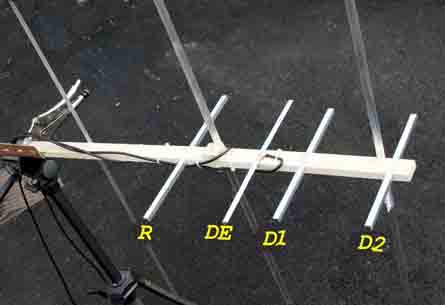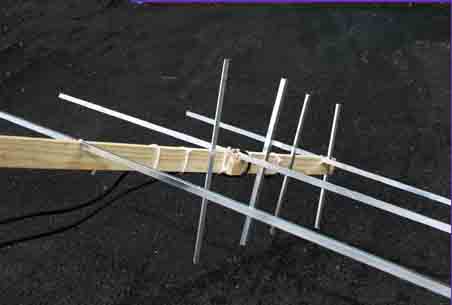
 G 8 G M U |
| Having heard a superb talk at the Coventry Amateur Radio Society by John Heath G7HIA about satellite working & the work of AMSAT... (it motivated me) I decided to have a play. Having looked at the prices of a suitable antenna & the implications for others just joining the hobby I produced a simple antenna design that required no special tools or knowledge beyond that a radio amateur should have, even a foundation licensee. The 'GMU / B&Q' antenna was born. Visit said DIY establishment walk out with antenna in 'kit form'. 1 piece of wood & 2 pieces of 10mm aluminum angle, screws & washers. |



|
|
This antenna really does work well, having now made many contacts through orbiting satellite A051. The tests being carried out in the full view of my neighbours who are about ready to certify me for the strange behaviour.
This is simple, tools required, accurate rule or tape measure, hacksaw, file drill, 3.5mm drill bit & set square if you must I didn't. Materials 10mm Aluminum angle. length of wood pack of screws & washers. This takes you as far as the connection to the co-axial feeder. First making the 435 MHz antenna using the dimensions set out here.
On the broad face of the wood measure in from one end 25mm & mark this will hold D2. measure 400mm & mark, this will hold the reflector R. This gives you the boom length of the 435 MHz antenna & the post ions from the second director D2 & reflector R respectively, do not cut anything yet. Measure & mark
for the driven element DE 155mm from the reflector, now from the driven element to the first director D1 measure 150mm & mark. your boom should now be marked out for the four elements (we count the driven element in its 2 parts as one element). Make sure the markings are square to the boom.
Very carefully cut a slot at each mark so the right angle aluminum slots in all the way down but is held tightly, very careful flexing of the timber will assist this as you offer one face of the angle into the saw cut. Check each saw cut in turn, that it will take one face of the angle.
Slot each element into its carefully sawn slot the angle should face to longest end of the boom (backwards) for all except he driven element the driven element should have a gap a the the centre of 8mm.
If you tried it I hope you were successful & heard something, when the antenna construction information is ended I shall go further into operating through AO51.
On the receive side I use a very old Kenpro KT 44. It is still good for simplex & repeater work but not up to the standards of a modern rig. The main downfall is the tuning. When tracking a satellite the RX needs to be re tuned to take into account Doppler shift. We are all familiar with Doppler shift as the police car races towards us the pitch of the siren increases and as it goes away the pitch reduces. The same thing happens with satellite communications I find an overall shift of at least 20 kHz, trying to tune this on the KT 44 is hard work, go for a rig with either continuos (stepless) tuning or one that will tune in 5khz steps. I also use a pre amp giving at least 12db gain to help recover signals at the beginning at end of some of the passes, this is not necessary. The signal from the 7 watt transmitter on AO51 is often 'very loud'. It is best to have separate TX & RX facilities so you can hear your signal through the satellite so you know you are in. The TX side is a Yaseu VX 150 currently borrowed from M3HBM. The output is 5watts which when taking the gain of the beam (at least 3dbd) is more than adequate. To access AO51 it currently requires a CTSS tone of 67Hz; there is no need to correct for Doppler on the up link.
I have upgraded the radios to a Yaseu VX-170E for the up link & a Yaseu VX-77 for the downlink. The 2 radios worn on a belt across the shoulder aids operating.
Working from an urban area, actually on the pavement by the QTH I heard over 12 countries in a very few days, and worked into France, Germany, Denmark,
Norway, Russia, Portugal a yes and someone a few miles away in Staffordshire. I am having fun with it, there is just something about hearing your signal coming back from space, it's nothing like using a land based repeater.
There has been little to add in the 3 years this antenna has been around;other than this has been used on dozens of occasions & worked through many satellites including ISS. The wiring has been tidied & a little reinforcing added due to rough handling. I have had many enquiries regarding the construction all with a good outcome. 73 from G8GMU
|